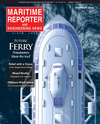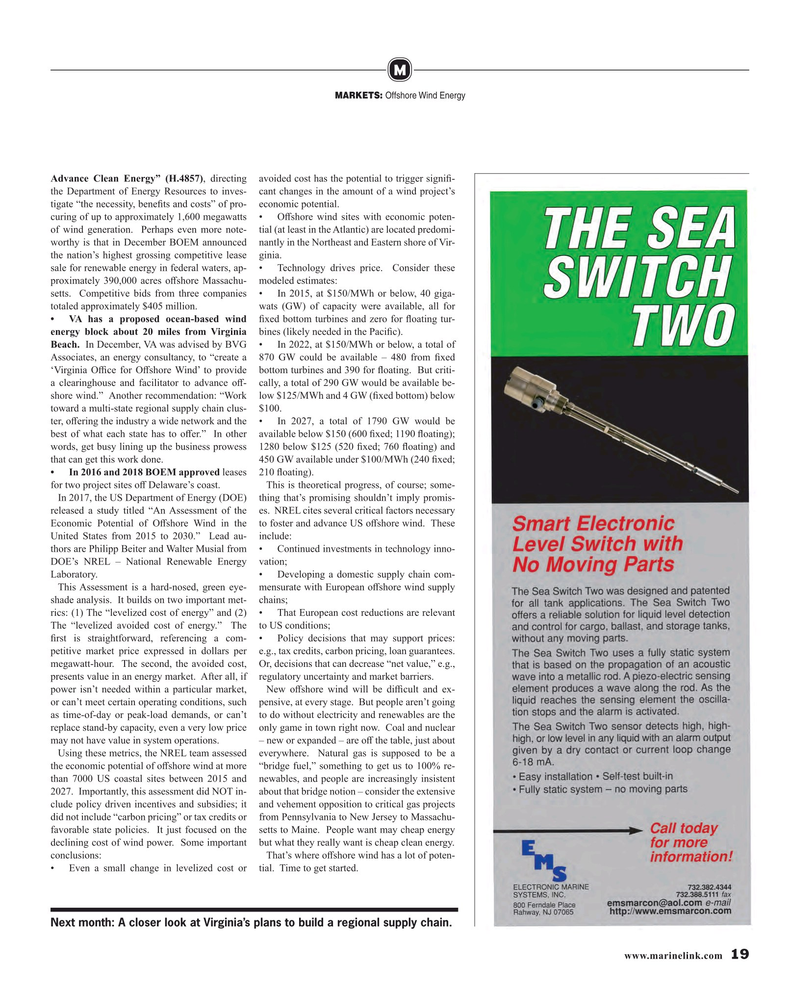
Page 19: of Maritime Reporter Magazine (February 2019)
Ferry Builders
Read this page in Pdf, Flash or Html5 edition of February 2019 Maritime Reporter Magazine
M
MARKETS: Offshore Wind Energy
Advance Clean Energy” (h.4857), directing avoided cost has the potential to trigger signif- the department of Energy Resources to inves- cant changes in the amount of a wind project’s tigate “the necessity, benefts and costs” of pro- economic potential.
curing of up to approximately 1,600 megawatts • Ofshore wind sites with economic poten- of wind generation. Perhaps even more note- tial (at least in the Atlantic) are located predomi- worthy is that in december BOEM announced nantly in the Northeast and Eastern shore of Vir- the nation’s highest grossing competitive lease ginia.
sale for renewable energy in federal waters, ap- • Technology drives price. Consider these proximately 390,000 acres ofshore Massachu- modeled estimates: setts. Competitive bids from three companies • In 2015, at $150/MWh or below, 40 giga- totaled approximately $405 million. wats (gW) of capacity were available, all for • VA has a proposed ocean-based wind fxed bottom turbines and zero for foating tur- energy block about 20 miles from Virginia bines (likely needed in the Pacifc).
Beach. In december, VA was advised by BVg • In 2022, at $150/MWh or below, a total of
Associates, an energy consultancy, to “create a 870 gW could be available – 480 from fxed ‘Virginia Ofce for Ofshore Wind’ to provide bottom turbines and 390 for foating. But criti- a clearinghouse and facilitator to advance of- cally, a total of 290 gW would be available be- shore wind.” Another recommendation: “Work low $125/MWh and 4 gW (fxed bottom) below toward a multi-state regional supply chain clus- $100.
ter, ofering the industry a wide network and the • In 2027, a total of 1790 gW would be best of what each state has to ofer.” In other available below $150 (600 fxed; 1190 foating); words, get busy lining up the business prowess 1280 below $125 (520 fxed; 760 foating) and that can get this work done. 450 gW available under $100/MWh (240 fxed; • In 2016 and 2018 BoEM approved leases 210 foating).
for two project sites of delaware’s coast. This is theoretical progress, of course; some-
In 2017, the US department of Energy (dOE) thing that’s promising shouldn’t imply promis- released a study titled “An Assessment of the es. NREL cites several critical factors necessary
Economic Potential of Ofshore Wind in the to foster and advance US ofshore wind. These
United States from 2015 to 2030.” Lead au- include: thors are Philipp Beiter and Walter Musial from • Continued investments in technology inno- dOE’s NREL – National Renewable Energy vation;
Laboratory. • developing a domestic supply chain com-
This Assessment is a hard-nosed, green eye- mensurate with European ofshore wind supply shade analysis. It builds on two important met- chains; rics: (1) The “levelized cost of energy” and (2) • That European cost reductions are relevant
The “levelized avoided cost of energy.” The to US conditions; frst is straightforward, referencing a com- • Policy decisions that may support prices: petitive market price expressed in dollars per e.g., tax credits, carbon pricing, loan guarantees. megawatt-hour. The second, the avoided cost, Or, decisions that can decrease “net value,” e.g., presents value in an energy market. After all, if regulatory uncertainty and market barriers.
power isn’t needed within a particular market, New ofshore wind will be difcult and ex- or can’t meet certain operating conditions, such pensive, at every stage. But people aren’t going as time-of-day or peak-load demands, or can’t to do without electricity and renewables are the replace stand-by capacity, even a very low price only game in town right now. Coal and nuclear may not have value in system operations. – new or expanded – are of the table, just about
Using these metrics, the NREL team assessed everywhere. Natural gas is supposed to be a the economic potential of ofshore wind at more “bridge fuel,” something to get us to 100% re- than 7000 US coastal sites between 2015 and newables, and people are increasingly insistent 2027. Importantly, this assessment did NOT in- about that bridge notion – consider the extensive clude policy driven incentives and subsidies; it and vehement opposition to critical gas projects did not include “carbon pricing” or tax credits or from Pennsylvania to New Jersey to Massachu- favorable state policies. It just focused on the setts to Maine. People want may cheap energy declining cost of wind power. Some important but what they really want is cheap clean energy.
conclusions: That’s where ofshore wind has a lot of poten- • Even a small change in levelized cost or tial. Time to get started.
Next month: A closer look at Virginia’s plans to build a regional supply chain.
www.marinelink.com 19

 18
18

 20
20
